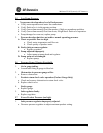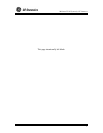
M
Millenium™ RO System by GE Osmonics
14693e - 31 Mar 03 5- 10 Troubleshooting
5.11 Low Percent Rejection
The overall membrane performance can be affected by a number of factors. Poor
rejection performance, as well as high TDS, can result from fouled membranes, low
pump pressure, inadequate waste flow, or feed water problems. An apparent
performance problem could be caused by a defective sensor or circuit board, and not be a
membrane issue at all. The recommended first step for any ‘membrane performance’
question is to confirm the rejection percentage and product TDS with a hand-held
RO/TDS meter. If the product water quality is poor, investigate the membrane.
However, if the water quality tests ‘normal’, investigate the monitoring circuits.
1. Waste flow too low.
a. Disinfectant or cleaner not rinsed from RO.
b. Check waste flow control.
c. Check for obstruction or kink in waste line.
2. Pump pressure too low.
a. Adjust pressure regulator.
b. Adjust pump settings.
3. Product flow too high.
a. See 5.9
4. Membrane scaled or fouled.
a. Verify condition of pretreatment equipment.
b. See membrane cleaning procedure in this manual.
5. Erroneous meter readout.
a. Verify water quality with independent meter and check conductivity probe
connection.
b. Check all quick-disconnect connections.
c. Replace inlet water sensor probe.
d. Replace product water sensor probe (percent rejection).
e. Replace monitor circuit board.
6. Membrane failure.
a. Replace membrane.
7. Change in feed water TDS.
a. Verify feed and product water quality with independent meter.
b. Softener problem, rinsing out high levels of salt.


















